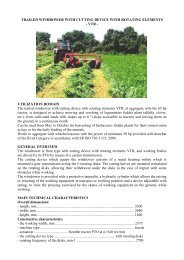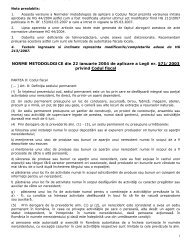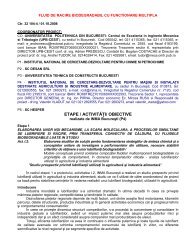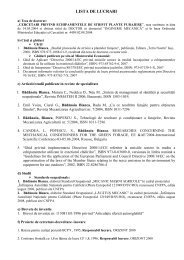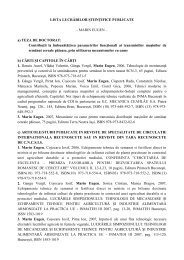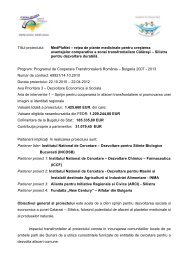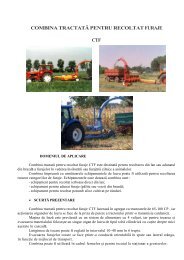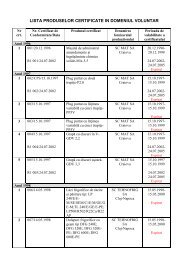january - april - Inma
january - april - Inma
january - april - Inma
Create successful ePaper yourself
Turn your PDF publications into a flip-book with our unique Google optimized e-Paper software.
Vol. 36, No.1 / 2012 INMATEH - <br />
unless the biodiesel, all other fuels considered<br />
shows decreases in available chemical energy<br />
content with values from a tenth of a percent to 2.4<br />
percent.<br />
42<br />
că, exceptând cazul biodieselului, toate variantele de<br />
combustibili considerate prezintă scăderi ale conţinutului de<br />
energie chimică disponibilă cu valori de la o zecime de<br />
procent la 2,4 procente.<br />
FUEL / COMBUSTIBIL<br />
DENSITY /<br />
DENSITATE<br />
Table 1 / Tabelul 1<br />
HEATING VALUE / PUTERE CALORICĂ<br />
[kg/l] [kJ/kg] [kJ/l] kJ/l , [%]<br />
diesel / motorină 0.840 / 0,840 41 800 35 100 100<br />
biodiesel / biodiesel 0.880 / 0,880 37 000 32 600 92.9 / 92,9<br />
vegetable oil / ulei vegetal 0.920 / 0,920 37 700 34 600 98.6 / 98,6<br />
mixture 90% diesel – 10% biodiesel /<br />
mixtură 90% motorină – 10% biodiesel<br />
0.844 / 0,844 41 300 34 857 99.3 / 99,3<br />
mixture 80% diesel – 20% biodiesel /<br />
mixtură 80% motorină – 20% biodiesel<br />
0.848 / 0,848 40 997 34 602 98.6 / 98,6<br />
mixture 70% diesel – 30% biodiesel /<br />
mixtură 70% motorină – 30% biodiesel<br />
0.852 / 0,852 40 313 34 346 97.6 / 97,6<br />
mixture 90% diesel – 10% vegetable oil /<br />
mixtură 90% motorină – 10% ulei vegetal<br />
0.848 / 0,848 41 355 35 069 99.9 / 99,9<br />
mixture 80% diesel – 20% vegetable oil /<br />
mixtură 80% motorină – 20% ulei vegetal<br />
0.856 / 0,856 40 919 35 026 99.8 / 99,8<br />
mixture 70% diesel – 30% vegetable oil /<br />
mixtură 70% motorină – 30% ulei vegetal<br />
0.864 / 0,864 40 490 34 984 99.7 / 99,7<br />
At first glance, the need to highlight and interpret<br />
performance deviations that exceed such natural<br />
differences calls for increase measurement accuracy of<br />
track parameters in the tests.<br />
Effectiveness of such increase is however limited<br />
because even in normal operation there are some<br />
variations in engine performance.<br />
One of the causes of such variations is the<br />
environmental state (atmospheric temperature, humidity<br />
and pressure) and to eliminate these influences have<br />
been developed correction procedures. At the same time,<br />
the engine itself may have some performance fluctuations<br />
induced by various factors such as thermal or technical<br />
microstates induced by previous operation, the test regimes<br />
sequence, some natural variability in the operation of the<br />
injection equipment controllers etc. In some comparative<br />
tests to assess motor behavior in alternative feeds, influence<br />
of such variations in performance should be removed.<br />
2. MATERIAL AND METHOD<br />
2.1. TEST DATA ACQUISITION AND PROCESSING<br />
The tests for comparative analysis of a Diesel<br />
engine energy performances under alternative supply<br />
must be made on a good technical condition test<br />
engine installed in a testing bed that allows operating<br />
mode control and precise measurement of main<br />
parameters of it (at least the speed, torque and horary<br />
fuel consumption).<br />
In essence, the test consists in determining the<br />
engine performance of the fuel supply for which it has<br />
been built (diesel) and alternative fuel supply.<br />
Usually, to eliminate possible errors caused by setting<br />
engine load controll (throttle position) such attempts will<br />
be made at full load regime, corresponding to maximum<br />
test engine performances. In these conditions, the<br />
evaluation of alternative fuel performance will be based<br />
on comparison of the two motor behavior. For<br />
eliminate, in this comparison process, any distortion<br />
caused by engine performance variations, it requires<br />
that the establishment of these performances to be<br />
made on statistical basis. This means that, for each<br />
type of supply, repeated attempts have to be<br />
performed, as described below.<br />
La prima vedere, necesitatea de a evidenţia şi<br />
interpreta abateri de performanţă care depăşesc astfel de<br />
diferenţe fireşti îndeamnă la o creştere a preciziilor de<br />
măsurare a parametrilor urmăriţi în cadrul încercărilor.<br />
Eficienţa unei astfel de creşteri este însă limitată<br />
deoarece chiar în funcţionarea normală motorului apar<br />
unele variaţii ale performanţelor.<br />
Una dintre cauzele unor astfel de variaţii o reprezintă<br />
starea mediului ambiant în perioada de încercare<br />
(temperatura, presiunea şi umiditatea atmosferică) şi<br />
pentru eliminarea acestor influenţe au fost dezvoltate<br />
proceduri de corecţie. În acelaşi timp, motorul în sine<br />
poate prezenta unele fluctuaţii de performanţă induse de<br />
factori diverşi, cum ar fi microstări termice sau chiar<br />
tehnice induse de funcţionarea anterioară, succesiunea<br />
regimurilor de încercare, unele variabilităţi fireşti în<br />
funcţionarea regulatoarelor din echipamentul de injecţie etc.<br />
În cadrul unor încercări comparative pentru evaluarea<br />
comportării motorului la alimentări alternative, influenţa unor<br />
astfel de variaţii de performanţă trebuie înlăturată.<br />
2. MATERIAL ŞI METODĂ<br />
2.1. OBŢINEREA ŞI PRELUCRAREA DATELOR<br />
Încercările pentru analiza comparativă a performanţelor<br />
energetice ale unui motor Diesel în condiţiile alimentării<br />
alternative trebuie să fie făcute pe un motor de test aflat în<br />
stare tehnică foarte bună şi instalat într-un stand de încercări<br />
care permite controlul regimului de funcţionare şi măsurarea<br />
precisă a parametrilor principali ai acestuia (cel puţin turaţia,<br />
momentul motor şi consumul orar de combustibil).<br />
În esenţă, încercările constau în determinarea performanţelor<br />
motorului la alimentarea cu combustibilul pentru care a fost<br />
construit (motorină) şi la alimentarea cu combustibilul alternativ.<br />
De regulă, pentru eliminarea unor posibile erori induse de<br />
stabilirea sarcinii comandate a motorului (poziţia comenzii de<br />
acceleraţie) astfel de încercări se vor face la regimul de sarcină<br />
totală, corespunzător performanţelor maxime de care motorul de<br />
test este capabil. În aceste condiţii, evaluarea performanţelor<br />
combustibilului alternativ folosit se va face pe baza comparării<br />
celor două comportări ale motorului. Pentru ca în cadrul acestui<br />
proces de comparare să fie eliminate eventualele distorsiuni<br />
induse de variaţiile de performanţă proprii motorului, se impune ca<br />
stabilirea acestor performanţe să se facă pe baze statistice.<br />
Aceasta înseamnă că pentru fiecare tip de alimentare trebuie<br />
efectuate încercări repetate, în condiţiile descrise în continuare.



